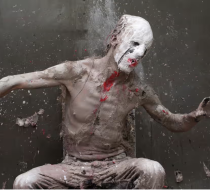The body as a living artwork: Olivier de Sagazan’s Transfiguration Favorite
As the audience enter, Olivier de Sagazan is pacing the stage, deep in thought. A slight, barefooted figure dressed in suit and tie, he circles in and out the shadows, head bowed, sometimes muttering to himself. As the audience settle and hush, his footsteps gradually become more audible (the floor is mic-ed) and begin to pound like a calling drum.
He kneels in front of a large block of clay, and dabbles his fingers in metal bowls of water set by his right and left hands. Originally a painter and sculptor, de Sagazan’s hands have a restless quality. They flicker and caress the air, pound the floor, and plunge into the clay which he proceeds to sculpt on himself, using it to morph and distort his face into a series of masks. It’s gloriously visceral to watch.
De Sagazan smooths wet clay into his skin and suddenly he is gone, leaving a grey creature in his place. He jabs two fingers into black paint and dots eyes into the mask. With his other hand he slashes red paint for a mouth. Tilting his head in the light, he jerks puppet-like. His mechanical gestures suit this faceless face, which, with its black circles for eyes, reminded me of the character of Hamm from Samuel Beckett’s Endgame. Indeed, Hamm is blind, and de Sagazan describes his method as ‘working blind’; the better to sense from within, and invite chance into his creations.
Tugging out the clay to make a nose, he plays with profiles. In a nod to Picasso, he paints two pairs of eyes. With lightning speed, he wipes it all away muttering, “Who am I?” It is the wiped face that is most frightening. Thick clay smoothed over his features creates a bland, terrifying monster. The suit makes the image all the more potent.
There are moments of black humour. De Sagazan becomes a shabby, winking crow, covered in straw, but the humour is undercut by his audible, laboured breathing (how is he breathing under there?), and the crow’s ‘caw’ distorts into an agonised cry. He breaks apart his face again, and reforms the clay into the ears and muzzle of a dog, who orates pointlessly at us, his voice totally muffled under the heavy mask. Images of identity, what we hide, what we fail to hide, what we show, and how we fail to express ourselves, emerge from texture, colour, light and shadow.
De Sagazan has said that the starting point for the piece was his frustration at trying to express himself through painting and sculpture. The overall quality of Transfiguration is anger, frustration, and violence. The artist destroys and rebuilds his ‘face’ over and over again, sometimes with horrifying brutality, as when he slams his head repeatedly into metal sheets hung behind him. This creates an ear-splitting noise, like a huge gong, and the impact of head on metal causes de Sagazan’s ‘face’ to fall from his bones in red-streaked lumps.
Much like the work of Beckett (who de Sagazan referenced in the post-show talk), the bleakness and black humour of Transfiguration speaks powerfully about the human condition. In the end there is a sense of catharsis. His body rigid with frustrated energy, he spits questions to himself: “Who am I?” “What is the story?” “What does it mean?” Spreading clay streaked with paint onto the panels behind him de Sagazan leaves us with a painting of sorts, one which contains the evening’s performance, and all his other faces.
It’s astonishing to believe that this is the London premiere of a work that de Sagazan has been performing and developing for over twenty years now. Breathless and filthy, his suit now in tatters, he told us, “I have to stop.” One senses of course, that he will in fact, go on.







